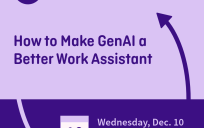In today’s world, data issues are work issues. When there are problems with the processes for gathering and analyzing data, they become problems for everyday workflows.
Take this team of business auditors at a state government, for example. While partnering with this team, Alteryx, an analytics platform provider, discovered that the auditors were identifying businesses to assess based on what they were reading in local papers. As one might deduce, their method of data collection was meager and inefficient, found in the pages of information meant for the general public and not for a skilled cohort of business auditors. They needed to upgrade their data pool without wasting time manually ingesting large quantities of data.
Inefficient manual processes, data complexity and the lack of talent were all barriers to efficient audit analyses. Automation, however, was able to relieve these pain points.
Analytic process automation (APA) unifies and automates the process of transforming data into insights. With APA, the team automated the processes of preparing data for analysis – gathering, cleaning, ingesting, etc. – so that they could draw auditing insights and conduct timely, valuable investigations. With automation, they didn’t need to be data scientists but instead could focus on what they were skilled at – business auditing.
“It’s about being able to leverage greater sources of data and automate that process of incorporating data into the analysis to find the connections and the anomalies,” said Andy MacIsaac, Alteryx’s Solutions Marketing Director for Public Sector.
Fortunately, APA can be employed for various use cases, from finance and human services to geospatial analysis. According to IDC, 44%, of data workers’ time is wasted on searching and preparing data. When these processes are automated, employees can focus on more valuable work across the board and agencies can achieve more impactful results.
“We’re augmenting the capability to do higher-level work,” MacIsaac said at GovLoop’s virtual event on data skills.
What else has government been able to achieve with APA? Here are some examples.
- A city government in Florida was able to shorten the time to identify abnormal water usage from 55 days to two. This helped preserve water resources and notified consumers of leaks or related issues in a timely manner.
- A state government was able to save over $1 million in duplicate payments. It was able to target the funds to priority issues and reduced organizational silos across departments.
- In the aftermath of a hurricane in Puerto Rico, an agency was able to identify and deploy resources to areas where damage was the greatest, affording a faster road to recovery.
“Once you’re able to focus on analytics, data science, automating processes and upskilling data literacy, that’s where organizations are going to realize breakthroughs,” MacIsaac said.
This online training was brought to you by:





Leave a Reply
You must be logged in to post a comment.